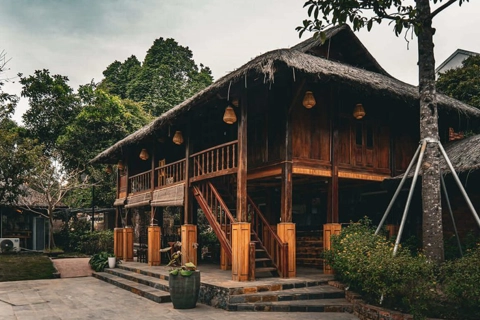Travel
Peach blossoms and kumquat in Hanoi West Lake welcome Tet
Dec 25, 2020 / 11:27 AM
Farms of flowers, peach blossoms, kumquat in Tay Ho district are Hanoi`s must-see destinations in the Lunar New Year festival.
Phu Thuong peach village
Located 4km to the west of Hanoi downtown, Phu Thuong has long been famous for many rice trades including making sticky rice, fermented sticky rice, rice balls sweet soup and millet cake (banh da ke). But no trade is more famous than traditional peach tree growing. Currently, the construction of Nhat Tan has reduced the acreage under peach trees. But the charm of a flower village stays intact. The remaining most fertile land of 116.7 ha is still under peach tree cultivation. Throughout the history, Phu Thuong peach village is a place that visitors can't miss on occasion of Lunar New Year. It is also the place where Hanoians come to take spring strolls and admire the blooming flowers for a new year full of joy.
Nhat Tan peach garden
Nhat Tan peach garden has long been a famous peach blossom brand of Hanoi. Located 7km northwest of Hanoi's downtown, the garden belongs to Nhat Tan ward. By the early 12th month of each lunar year, Nhat Tan peach garden becomes more vibrant in the soft sunshine of winter with the bustling atmosphere in the days leading up to Tet.
And in spring, the flower village is crowded again as visitors come to contemplate flower. Nhat Tan peach earned its fame with big blossoms, thick pink petals arranged into multilayers around the fresh yellow stigma, green leaves shaped like dagger-axe head and branches rising upward. Apart from peach blossom, the garden is also planted with other colorful flower beds such as daisy, cosmos, violet, sunflower, globe amaranth and ylang ylang vine, making it an ideal site for sightseeing and taking photos.
Nhat Tan peach blossom is not only famous in Vietnam, but also well-known in many countries and becomes the pride of Hanoi in particular and of the whole country in general.
Quang Ba kumquat village
Not far from Nhat Tan peach garden, Quang Ba kumquat village in Quang An ward, Tay Ho district is the next noteworthy destination for visiting. Thanks to the fertile land and the people's care, kumquat trees here always bears fruits and are pruned as well as shaped elaborately.
The same Nhat Tan kumquat tree but planted somewhere else is stunted and bears small fruits.
The exceptional rich soil of Nhat Tan village which nurtures the intense and extraordinary vitality of the kumquat tree is the reason for this. Therefore, gardeners in Quang Ba don't need to hawk their kumquat trees. Guests who are connoisseurs of kumquat often come to the gardens to buy. Apart from kumquat, many varieties of high quality flower imported from abroad such as Dutch daisy, Japanese daisy, Thai lily and French rose are grown on the area of accretion along the Red River.
Tu Lien kumquat village

Another village in the surroundings of Tay Ho district which also fares very well during the Tet festival is Tu Lien village. Used to be a kumquat farming village, Tu Lien has now turned to be a huge flower market as the farming land is lost to urbanization. Going round the West Lake through the Quang An flower market, the "Tu Lien tradditional kumquat village" sign comes into your sight.
Kumquat which is mostly harvested from Van Giang kumquat gardens (Hung Yen province), distinguishes thanks to the skillful hands of artisans. Although the village is not the ideal area for photo shooting, it still attracts visitors because it's just a few steps away from the ornamental tree village of Nghi Tam.
Nghi Tam ornamental tree village

Being one of the three ancient villages of Quang An ward, Tay Ho district, Nghi Tam village is both a historical and cultural landmark, and a famous traditional craft village. The most distinctive trade is ornamental tree growing.
Nghi Tam's ornamental tree planting was originated in 1928 by a man from the village who sold the trees to the Chinese at Cat Linh street and brought the variety to raise in the village. Similar to Quang Ba garden, Nghi Tam is also famous for fresh and beautiful fruit-bearing kumquats. Nghi Tam garden starts to be busy from the 23rd day of the 12th lunar month of each year.
 Phu Thuong peach village. |
Nhat Tan peach garden
 Nhat Tan peach garden. |
And in spring, the flower village is crowded again as visitors come to contemplate flower. Nhat Tan peach earned its fame with big blossoms, thick pink petals arranged into multilayers around the fresh yellow stigma, green leaves shaped like dagger-axe head and branches rising upward. Apart from peach blossom, the garden is also planted with other colorful flower beds such as daisy, cosmos, violet, sunflower, globe amaranth and ylang ylang vine, making it an ideal site for sightseeing and taking photos.
Nhat Tan peach blossom is not only famous in Vietnam, but also well-known in many countries and becomes the pride of Hanoi in particular and of the whole country in general.
Quang Ba kumquat village
 Quang Ba kumquat village. |
The same Nhat Tan kumquat tree but planted somewhere else is stunted and bears small fruits.
The exceptional rich soil of Nhat Tan village which nurtures the intense and extraordinary vitality of the kumquat tree is the reason for this. Therefore, gardeners in Quang Ba don't need to hawk their kumquat trees. Guests who are connoisseurs of kumquat often come to the gardens to buy. Apart from kumquat, many varieties of high quality flower imported from abroad such as Dutch daisy, Japanese daisy, Thai lily and French rose are grown on the area of accretion along the Red River.
Tu Lien kumquat village

Another village in the surroundings of Tay Ho district which also fares very well during the Tet festival is Tu Lien village. Used to be a kumquat farming village, Tu Lien has now turned to be a huge flower market as the farming land is lost to urbanization. Going round the West Lake through the Quang An flower market, the "Tu Lien tradditional kumquat village" sign comes into your sight.
Kumquat which is mostly harvested from Van Giang kumquat gardens (Hung Yen province), distinguishes thanks to the skillful hands of artisans. Although the village is not the ideal area for photo shooting, it still attracts visitors because it's just a few steps away from the ornamental tree village of Nghi Tam.
Nghi Tam ornamental tree village

Being one of the three ancient villages of Quang An ward, Tay Ho district, Nghi Tam village is both a historical and cultural landmark, and a famous traditional craft village. The most distinctive trade is ornamental tree growing.
Nghi Tam's ornamental tree planting was originated in 1928 by a man from the village who sold the trees to the Chinese at Cat Linh street and brought the variety to raise in the village. Similar to Quang Ba garden, Nghi Tam is also famous for fresh and beautiful fruit-bearing kumquats. Nghi Tam garden starts to be busy from the 23rd day of the 12th lunar month of each year.








